Menu
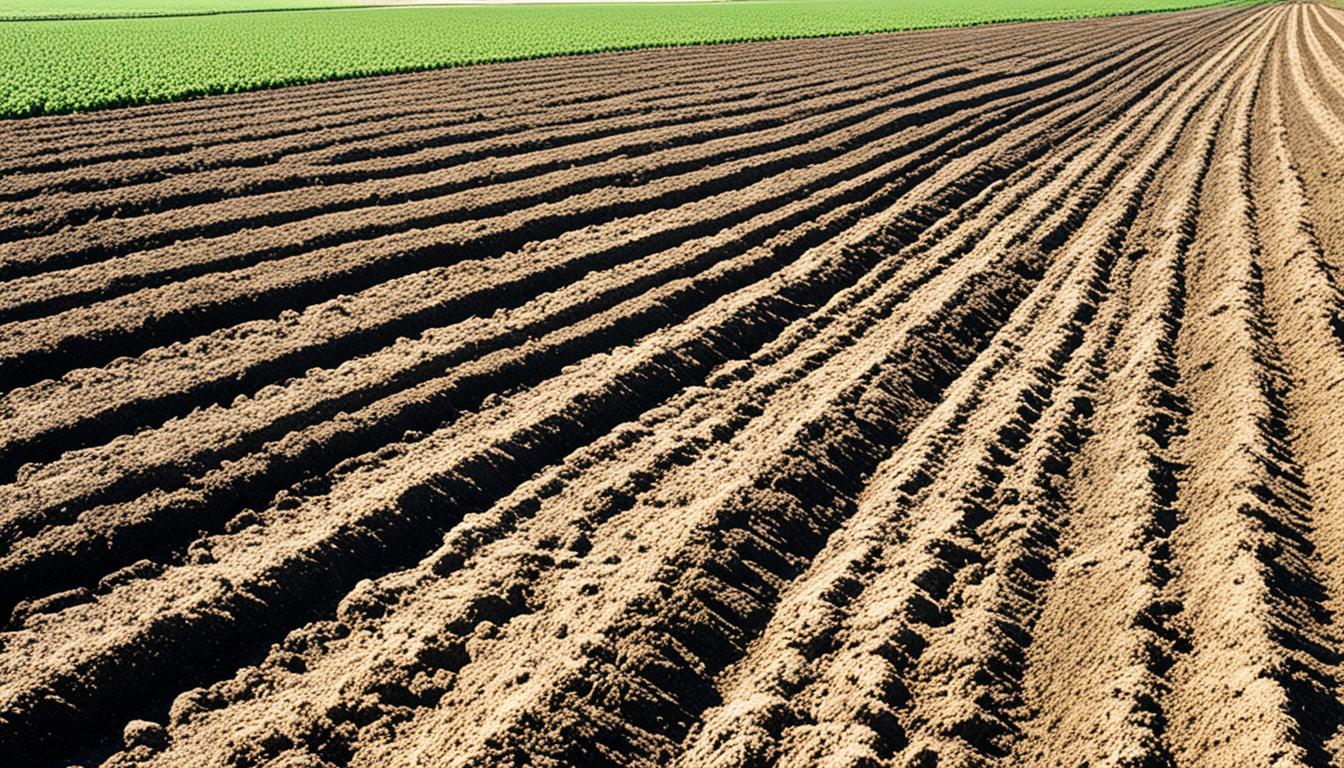
In the last 50 years, the Midwest lost about half of its topsoil to erosion, much of it due to human activity. Erosion control is key to protect the earth, water, and scenery from erosion’s harm. Water, wind, and our actions can start erosion, harming the land’s health and its ability to grow food. We need to use methods like barriers, stabilisers, and plants to stop this.
It’s very important to keep erosion control methods up. Big storms and heavy wind can test even the best of our solutions. Getting advice from experts, like a GEO Pro, helps match the best techniques for each spot.
Protecting soil from erosion is essential for managing the land well. We use various methods to stop soil from washing or blowing away. This is key for keeping the land fertile, supporting wildlife, and keeping our water clean.
Over the past 50 years, the Midwest has lost a lot of topsoil. Human activities have sped up soil erosion. In places such as Iowa, an average of 6.8 inches of topsoil has been lost since 1850. This shows how important it is to protect our soil.
Soil erosion in the US costs around $37.6 billion each year. Sadly, much of the soil that washes away ends up in our water, causing problems like algal blooms. The Midwest, in 2019, faced heavy spring rain that washed away a lot of soil, making this issue worse.
Stopping soil erosion does more than just save soil. It helps protect water quality and supports the environment. Water erosion is a big issue in places like Iowa. Research shows erosion affects soil health, which can harm farming.
We can reduce erosion by changing how we till the soil. No-till, strip-till, and ridge-till practices are good for this. A study found that keeping the soil covered helps to reduce erosion. This highlights the need for sustainable farming techniques.
“Soil erosion can lead to once fertile lands becoming uncultivable and eventually abandoned,” experts warn. To stave off this threat, we must adapt our methods to fight erosion against climate changes. Wind erosion in dry areas worsens the global challenge of soil loss and water pollution.
It’s crucial to use these strategies to protect our land. By tackling different types of erosion, we keep our soil and ecosystems healthy for the long run.
| Erosion Type | Description | Impact |
|---|---|---|
| Sheet Erosion | Uniform loss of soil in thin layers | Depletion of nutrient-rich topsoil |
| Wind Erosion | Soil particles transported by the wind | Soil fertility loss and air pollution |
| Rill Erosion | Formation of small channels on the slope | Increases surface runoff and loss of arable land |
| Gully Erosion | Large channels formed by the coalescence of rills | Severe land degradation and loss |
| Ephemeral Erosion | Temporary gullies that can be removed by tillage | Temporary but recurring soil loss |
To sum up, it’s clear that managing soil erosion is crucial for a sustainable future. By protecting our soil, we also save our water and support the ecosystem.
Soil erosion control is crucial for keeping soil healthy, water clean, and the environment balanced. For places like construction sites, it’s important to have strong measures. This helps avoid big environmental problems in the long run.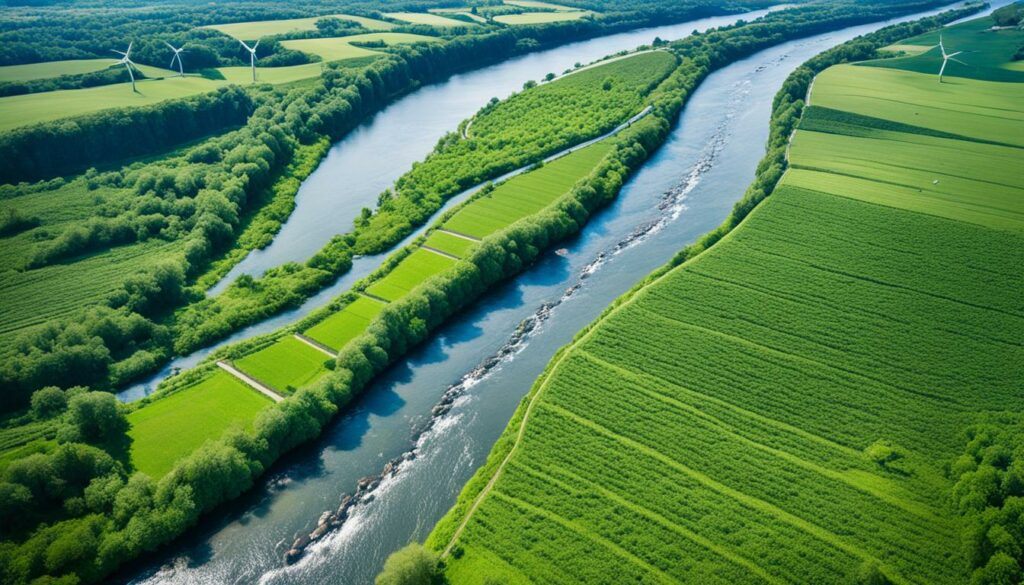
Good soil conservation keeps soil healthy and productive. Without it, the topsoil that plants need can be lost. The U.S. loses about $37.6 billion a year because of this. It affects farming and the soil’s ability to grow things. Using methods like erosion control blankets helps keep soil rich and stable.
Stop soil erosion to keep water clean. Both wind and water can move dirt and pollutants into rivers and lakes. This makes the water dirty. For example, pollution from farms has made places like Lake Erie unsafe to use water from. Using Aqua-Barrier solutions at construction sites can help stop water pollution.
Soil erosion impacts our ecosystems a lot. It can harm where animals live and what they eat. About 60% of eroded soil ends up in water, hurting fish and other creatures. Preventing soil erosion is vital for protecting wildlife and their homes. It is an important part of taking care of our planet and ensuring it remains habitable for all.
Physical erosion control methods help a lot in managing soil erosion. They work well in places with heavy rain or strong winds. The methods include barriers, terracing, and geosynthetics. These techniques are key in stopping soil loss and keeping the land solid.
Barriers are essential in stopping erosion. They slow down water and wind. Plant barriers are cheap, costing between $50 to $100 a mile. They are easy to care for and only need fixing after big storms or if the ground is dug.
Crops like corn and hay leave things behind that stop erosion. Planting without digging helps keep this cover on the ground. This way, soil is healthier and stays where it should be.
For hilly areas, terracing and contouring are really helpful. They create flat steps on slopes. This slows down water and helps it soak into the ground. On steep slopes, terracing cuts down soil loss a lot.
Planting hedges along the slope also helps. They block wind and water. Plus, they are like a natural carpet that holds the soil in place.
Geosynthetics are a great addition to erosion control. They provide a strong, stable layer over the soil. This layer keeps the soil where it belongs even during heavy rains. Geosynthetics make traditional methods last longer.
In the modern market, there are also special products. Global Road Technology’s GRT Nature Plus and GRT Enviro-Binder offer new solutions. GRT Nature Plus helps plants grow and controls erosion. GRT Enviro-Binder gives strong protection even after wildfires.
These new materials show how we can fight soil loss. They help us look after our land better and for longer.
Learning about chemical erosion prevention techniques is key to good soil care. These methods use different compounds to keep soil together. This stops erosion and makes the soil better. Let’s focus on two main ways: using soil stabilisers and certain chemicals like pesticides and herbicides.
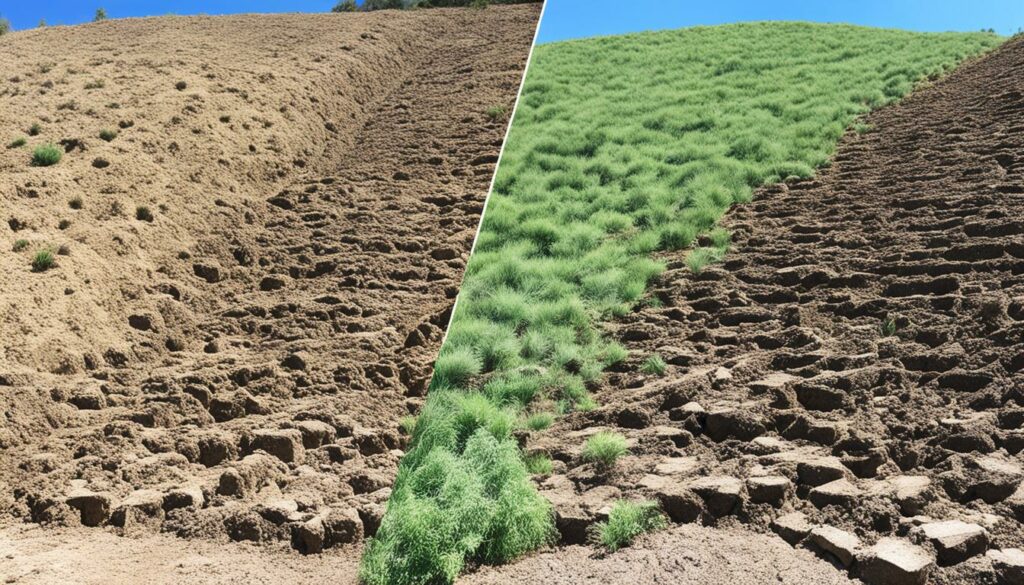
Soil stabilisers, like cement and lime, play a big part in keeping soil stable. For soils that don’t stick well, cement can make them stronger. Lime uses special types of lime to dry out damp soils, making them more solid. Polymers, which are man-made materials, can also help. They’re good for the environment and cheaper. But, some polymers can harm water creatures, so we have to be careful.
| Chemical Type | Cost | Application Rate | Environmental Impact |
|---|---|---|---|
| Chloride Compounds | $0.50 per pound | 1-3 tons per acre | May limit vegetation establishment due to toxicity |
| Polyacrylamide | $6 per pound | 20 pounds per acre | Reduces permeability, assess for aquatic impact |
Using pesticides and herbicides for erosion control is another part of chemical stabilisation. These chemicals control plants that might cause soil to erode. By managing plant growth, the soil stays protected. Hydraulically Applied Mulches, which can be sprayed on, mix these chemicals with a shield layer. This helps seeds grow well. But, we need to pick chemicals that won’t hurt water life.
To sum up, chemical stabilisation and erosion control can work really well. But we need to choose and use them wisely. Doing these things right helps the soil and keeps our planet healthy.
Vegetative stabilisation plays a key role in managing soil erosion. It uses a mix of cover crops and grasses, which reduces the effects of water and wind. This helps with both preventing erosion and getting the right nutrients into the soil for plants to grow.
When done properly, temporary seeding can slash erosion by 99%. Using two tons of mulch per acre is key here. The C factor, a measure of soil loss, proves that native plants cut loss by 99%. But, the efficiency of different grasses and mulches varies, shown by their C factor values.
To get vegetative stabilisation right, preparing the seedbed is critical. Good seeds make sure plants will grow well and stop erosion. A cover of under 50% is not enough to prevent erosion. So, careful preparation and choosing the best plants are very important.
Using vegetative stabilisation can do a lot to manage soil erosion. It stops soil loss and helps reduce nutrient and phosphorus levels. These methods make sure our soil stays good for use in the future.
To control erosion effectively, a full approach to water management is key. It’s crucial to lead water away from places that are vulnerable. Drainage systems and ponds are top choices for fighting erosion.
Drainage systems play a big part in erosion control. They help move water away from places that could erode. This stops soil from being washed away by water. Systems like ditches, swales, and underground drains can move different amounts of water. They keep the land from getting too wet, which prevents soil erosion.
Retention ponds are also important for managing water. They store stormwater for a while before slowly releasing it. This lessens the impact of water flow, reducing soil erosion and sediment movement. These ponds can also support wildlife, enhancing the local ecosystem.
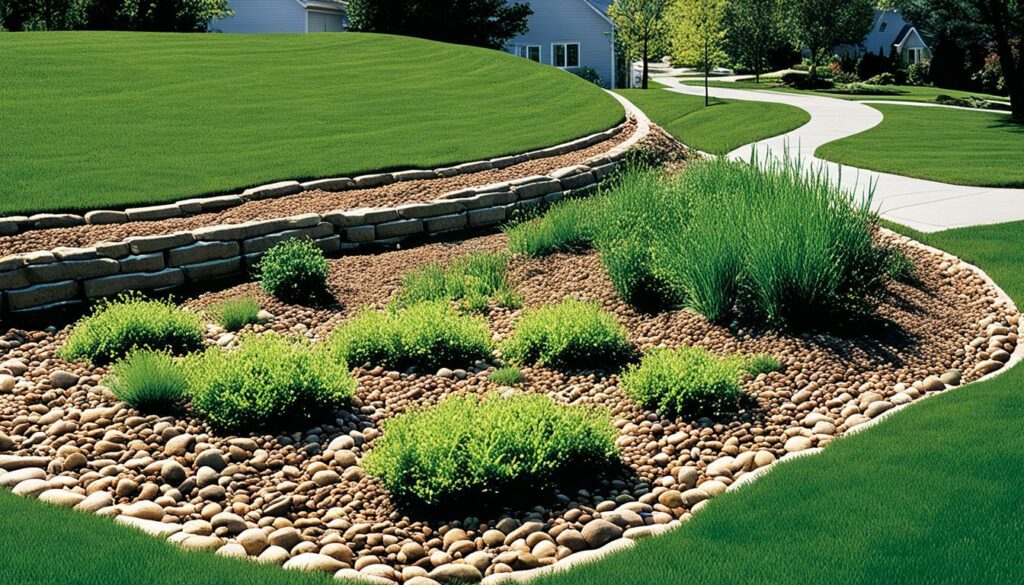
By combining drainage and ponds with other methods and plant cover, we build a strong defence against erosion. It’s vital to look after these systems, especially after heavy rain, to keep them working well.
Using cover crops and mulching in farming is key. They help keep soil in place and make it healthier. These practices lower erosion and boost crop growth, soil richness, and how well the farm works.
Cover crops are great for the earth and farming. They are being used more, covering 15.4 million acres in the US in 2017. This was a 50% jump in planting from five years before. The fact that so many states have doubled their use of cover crops between 2012 and 2017 shows their positive impact on soil and farm success.
Using cover crops can make a big difference in yield. For instance, there’s a 3% boost in corn and a 4.9% increase in soybeans after five years. In dry seasons, like 2012, they help even more. Then, there’s up to a 9.6% increase in corn and an 11.6% increase in soybeans. Also, cover crops without legumes catch 30-50 pounds of nitrogen per acre, which is good for the soil.
Mulching also helps to stop erosion. Research by Li, Li, & Pan in 2021 and Iqbal et al. in 2020 shows that mulching protects soil and water, keeping the right amount of heat and moisture. Using rice-straw mat mulching, for example, has made soil better in apple orchards, as Cao et al. (2021) found.
An essential layer, mulching keeps soil safe from things that blow or wash it away. The right mulching can stop as much as 90% of soil erosion, especially in bad weather. This protection is critical to keep farms productive.
By using cover crops and mulching together, we can better defend against soil erosion. These methods help the soil keep key nutrients and water, leading to more crops and stronger farms.
| Statistic | Value |
|---|---|
| Increase in cover crop acreage (2012-2017) | 50% |
| Cover crop acreage in 2017 | 15.4 million acres |
| Expected corn yield increase after 5 years | 3% |
| Expected soybean yield increase after 5 years | 4.9% |
| Yield increase in 2012 drought (corn) | 9.6% |
| Yield increase in 2012 drought (soybeans) | 11.6% |
Keeping a good perennial plant cover is key to stopping soil erosion. It’s important because 84% of erosion comes from water and wind. The roots of these plants grip the soil, which stops water from carrying it away.
With perennial plant cover, soil stays safe all year. In the United States alone, 5 million acres see serious damage every year from elements and people. Plants help the soil stay put even when heavy rains or landslides happen. They stop the land from losing its top layer.
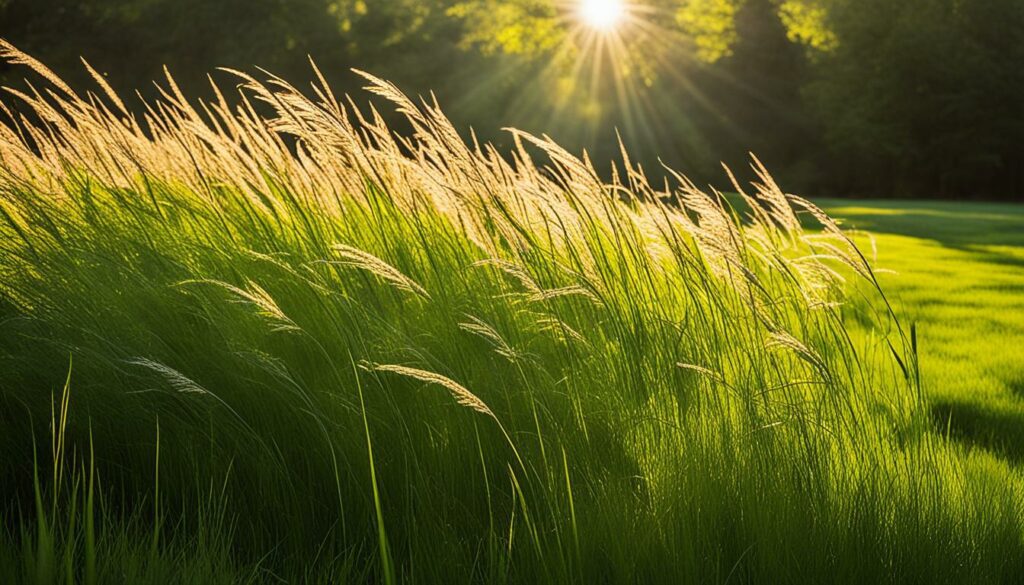
To fight water erosion, grass like Purple Threeawn works great, especially on hills. Also, trees such as Cascara, Fir, and Western Red Cedar help keep the soil down the hill. This makes the ground stronger and less likely to wash away.
Native grasses are excellent because they don’t need much cutting. This is good news for farmers. Plants that are well-taken-care-of can prevent deep gullies from forming. This type of erosion is very bad for the soil. Using gentle farming methods, like not tilling the land, can really help. It’s a common method in places like Pennsylvania, where a lot of the land is prone to erosion.
So, choosing to grow a lot of healthy perennial plants is a smart move. It’s good for the land in a natural way. It helps keep soil from washing away and keeps the land useful.
| Type | Recommended Plants | Benefit |
|---|---|---|
| Grass | Purple Threeawn | Erosion control on slopes |
| Tree | Cascara, Fir, Pine, Willow, Big-Leaf Maple, Western Red Cedar | Downslope erosion control |
| Native Grasses | Various species | Low maintenance, soil stabilisation |
Keeping soil stable in busy places is key to stop too much soil washing away. Ways to do this are important when lots of people or vehicles move over an area.
To control erosion in these places, you can use gravel and wood chips. Gravel makes the ground strong, stopping it from moving and lets water flow through. Wood chips are a natural choice that looks good too. They stop weeds and add a touch of nature.
Putting down sod or using hydroseeding is also great for fighting erosion. Sodding means laying down grass that’s already grown. It quickly covers the ground, making it strong against erosion. Hydroseeding spreads a mix of seeds, mulch, and food over the soil. It helps plants grow fast. This is very good for steep areas or places where it’s hard to plant.
Using gravel for erosion control and methods like sodding and hydroseeding really help. They keep the area stable and last for a long time, which is good for nature and people.
It’s crucial to manage stormwater to prevent soil erosion and keep water clean. This water often carries pollutants like silt and debris. Effective strategies can reduce these impacts.
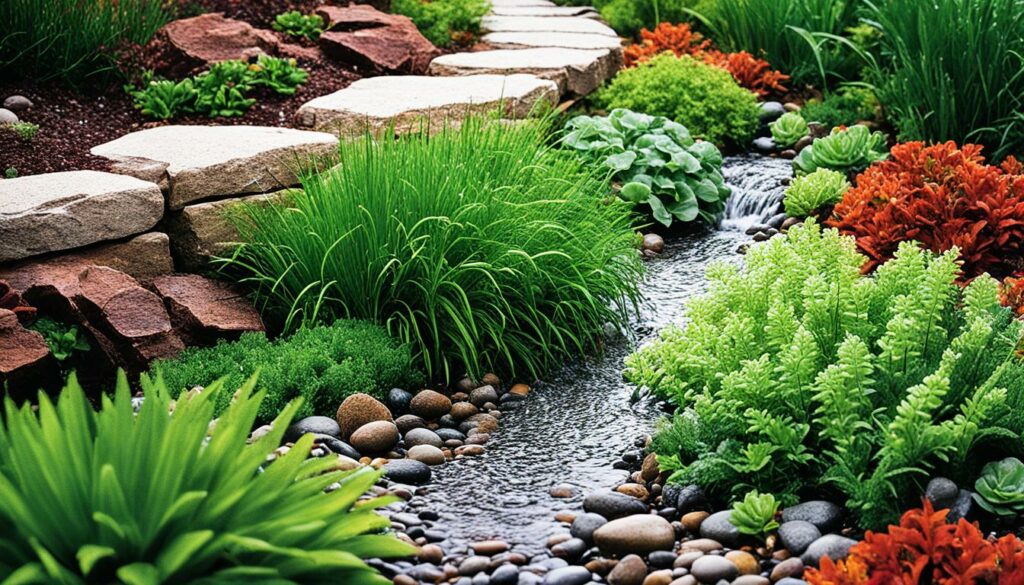
Rain gardens help control stormwater. They absorb rainwater and filter it. This reduces water speed and contamination. Plants and soils in these gardens clean the water.
They improve water quality before it gets to rivers and lakes. These gardens also make urban areas look better.
Underground systems are good for areas with little space. They store extra water and release it slowly. This helps keep soil in place and filters out pollutants.
For big construction projects, these systems are often needed. They prevent pollution and protect water quality.
By using methods like rain gardens and underground systems, we handle stormwater well. These approaches protect our water and the environment for the future.
Restoring vegetation in bare spots is key to stopping erosion. These spots can happen due to bad growing conditions or runoff. It’s important to pick the right plants and soil changes for success.
For big erosion problems, use strong tactics like check dams or terraces. Terraces on steep slopes help by changing how water flows, reducing erosion. In places that get walked on a lot, using stepping stones or paths can really help keep the ground safe.
When there’s something in the way of stormwater, move it to stop erosion. Putting in things like stones or riprap helps protect these areas. Checking gutters and pipes often also prevents erosion near them.
Plants that are from the area can save water and fit local rain patterns. This means less work to look after them and more kinds of plants growing. Mixing grasses, legumes, and forbs, around six to ten types, makes soil and the area more stable. Trees with grasses are a good mix too, as they help the soil and don’t fight for space.
It’s important to plan how to stop erosion by looking at the soil, how much erosion there is, and other details. Checking these things often helps make sure the solution works and the land stays healthy.
| Erosion Control Technique | Application |
|---|---|
| Vegetative Replanting | Light erosion problems |
| Mulch Covering | Light erosion problems |
| Check Dams and Terraces | Heavy erosion in concentrated flow areas |
| Stepping Stones/Gravel Paths | Areas with heavy foot traffic |
| Native Plant Implementation | Long-term erosion control and biodiversity enhancement |
| Stone/Riprap Placement | Protection around obstacles |
Terraces and check dams are key to stopping erosion on steep lands. They slow down water, so less soil is washed away. This keeps the ground firm and fertile.
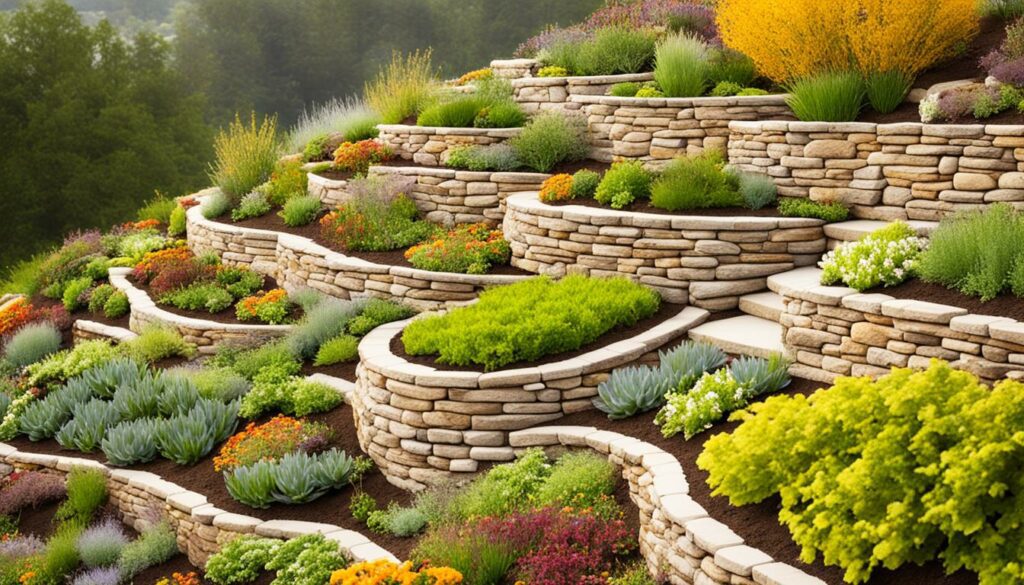
Building terraces follows the land’s natural lines to stop soil from moving. Making many smaller terraces on very steep slopes works best. The Loess Plateau region is a good example, where 37,130 km² was terraced by 2012.
Check dams help terraces in erosion fight. They’re put in natural water paths to slow the water, stopping soil from being taken away.
Using terraces and check dams is a smart way to manage soil erosion on hills. They have a big impact on keeping the ground healthy and erosion-free.
Maintaining soil fertility helps plants grow strong and cover the ground well. This stops the land from eroding. Adding things to the soil, like nutrients and structures, boosts its health. This makes it easier for plants to grow, helping the soil stay in place. In Queensland, adding the right stuff to the soil is key to growing crops that feed many people. It shows how vital good soil care is for farming.
Working the land often can take away the natural things in it that help plants grow. This happens a lot when parts of the plant are taken away or burnt. Sticking to the land or adding less new soil are better. They help keep the good stuff for plants at the top, close to their roots. Yet, not much rain makes it tough for plants to use what’s deep down. Adding special things to the soil can help keep it full of what plants need. This way, the soil has all it needs to give plants a good start.
Some nutrients are lost when things like rain or wind wash them away, or when plants are burnt. These things don’t only make the soil poorer but also harm the environment. Using the right amount and type of food for plants can help. But it’s very important to think about what is best, using what we know. Adding helpful things to the soil can stop the soil from losing what plants need to grow. My work aims to keep the soil in top condition, making sure we grow food in a way that’s good for the Earth.
To control soil erosion, you can use physical barriers like sediment control logs and fencing. Also, terracing and contouring help. Geosynthetics, chemicals stabilised with polymers or cement, and vegetative stabilisation with cover crops and grasses are useful too.
Polymers and cement, as chemical stabilisers, make soil particles stick together better. This way, soil stands stronger against being washed away. They work well where other methods might not be an option.
Planting cover crops and grasses is essential for stopping soil from washing or blowing away. They keep the soil healthy and help new plants grow. This protects the soil from erosion by water and wind.
Drainage systems like ditches and swales, and retention ponds, help control water flow. They stop too much water from sitting on the land, which can cause erosion. These systems are key to keeping the soil stable and preventing erosion.
Cover crops, including winter rye, protect the soil. They make the soil healthy and lessen the chance of it eroding. Mulching keeps moisture in, stops erosion, and helps keep the ground at the right temperature.
Perennial plants keep the soil safe all year. Their roots stop water from running off and help prevent erosion. They are a great defence against the erosion caused by changing weather.
Places with a lot of foot or vehicle traffic can use materials like gravel and wood chips to protect the soil. Sod and hydroseeding also help to quickly grow plants that cover the soil well. This is especially good on steep slopes.
Rain gardens are gardens that soak up and clean rainwater. They stop soil from washing away and make the water cleaner by catching dirt and pollutants. They are a green way to handle stormwater.
Terraces slow down water moving down slopes. Check dams in water paths also stop water, reducing soil movement. These methods change how water flows, helping to save the soil from erosion.
Changing the soil’s nutrients and structure helps plants grow strong. This protects the soil from being washed away. Good soil is crucial for holding off erosion effectively.